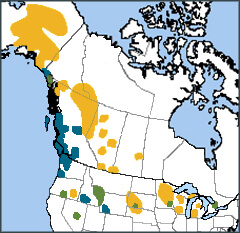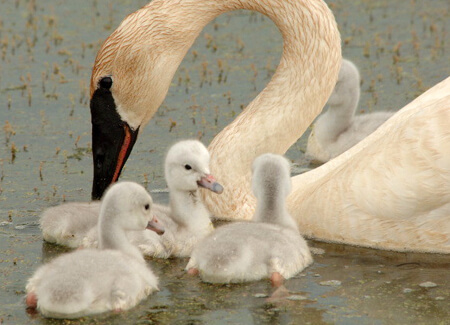 The beautiful white Trumpeter Swan is named for its sonorous calls, which are often compared to the sounds of a French horn. This majestic swan is the largest waterfowl species native to North America, reaching up to 35 pounds, and is one of the heaviest flying birds in the world.
The beautiful white Trumpeter Swan is named for its sonorous calls, which are often compared to the sounds of a French horn. This majestic swan is the largest waterfowl species native to North America, reaching up to 35 pounds, and is one of the heaviest flying birds in the world.
The Trumpeter once bred widely across North America, but by the early 20th century had declined to near-extinction because of market hunting and habitat loss. Although numbers have rebounded as a result of intensive conservation and habitat protection, Trumpeter Swans are still threatened by lead poisoning, collisions, illegal shooting, and habitat loss.
The Three Swans
Three swan species can be found in North America: the native Trumpeter and Tundra Swans and the non-native Mute Swan. The latter is native to parts of Europe and Asia; unfortunately, Mute Swans often out-compete native swans and other bird species for habitat and food.
The Trumpeter Swan is sensitive to human disturbance and pollution. The species does best in clean, quiet waters that provide invertebrates and aquatic plants for food. It matures late, not nesting until young birds are four to five years of age, and forms life-long pair bonds.
Sign up for ABC's eNews to learn how you can help protect birds

Trumpeter Swan with cygnets by Arnie Frederickson, The Trumpeter Swan Society, www.trumpeterswansociety.org
Learning for Life
Trumpeter Swans form pairs at three or four years of age, then tend to stay together throughout their lives. The male and female birds travel together when the birds migrate. These swans cover their eggs with their enormous webbed feet to keep the eggs warm—an unusual habit. (Penguins like the King Penguin warm their eggs on top of their feet instead.
Young swans, called cygnets, remain with their parents through their first year, learning traditional migration routes and wintering spots from adult birds.
The recovery of the Trumpeter Swan is an inspiring reminder that concerted bird conservation efforts can bring back the birds; other conservation success stories include Swainson's Hawk and Bald Eagle.
Bringing Back the Birds
Our Migratory Bird Program is expanding its efforts to ensure that priority bird species have the necessary habitat and protections across their life-cycles. As this example featuring Wood Thrush shows, migratory birds face many threats across their migratory journeys; ABC programs are working to reduce those threats and preserve the miracle of migration.
Donate to support ABC's conservation mission!



















































